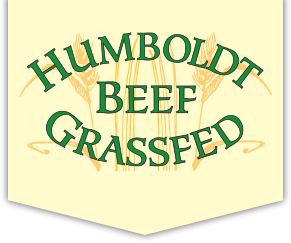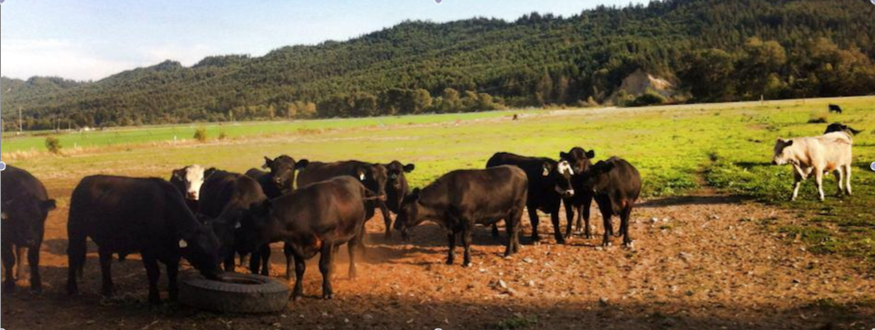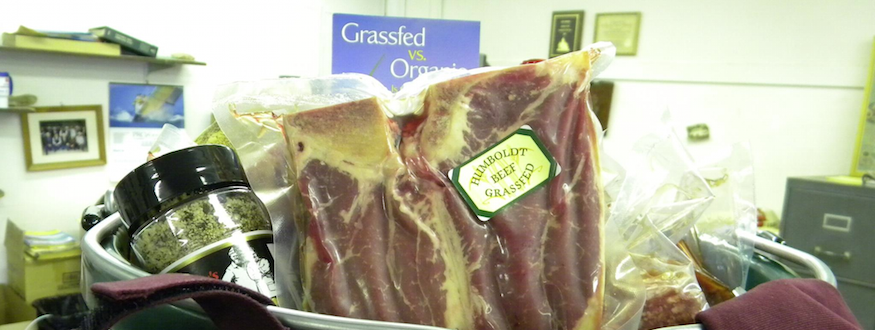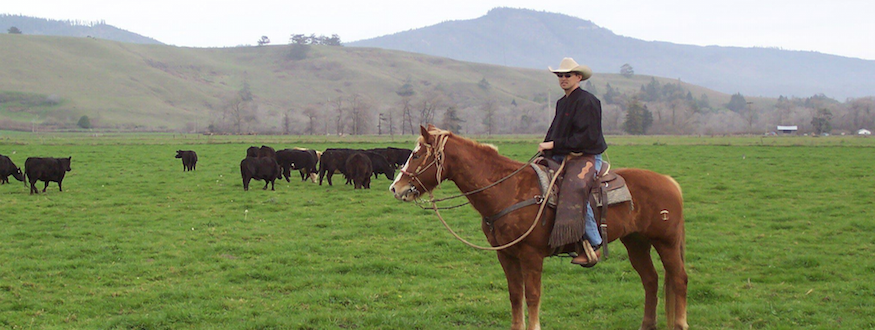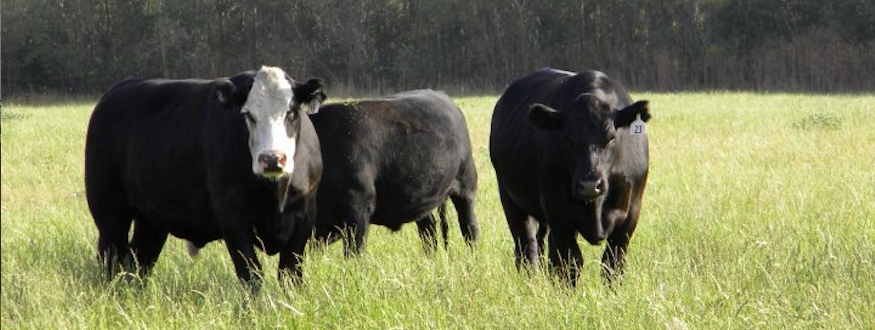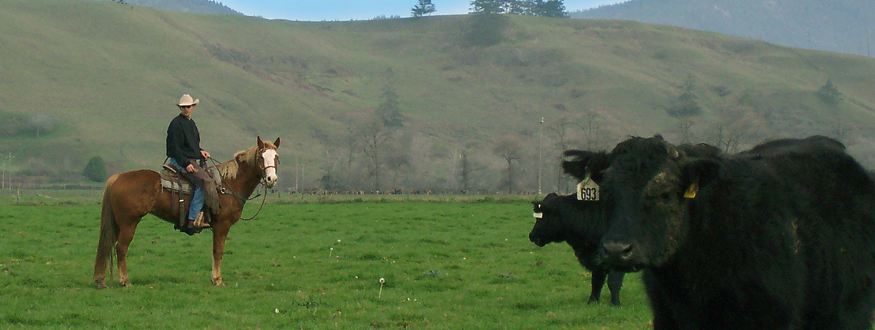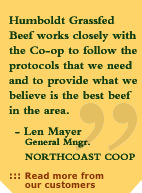Times-Standard (Eureka, California)
October 8, 2008
The Business of Beef
by Sharon Letts
What makes a happy cow?
Grass and grazing to the end of their days, says Sarah Mora, a fifth-generation cattle rancher and the sales and marketing representative for her family's beef business, Humboldt Grassfed Beef.
“The main difference between grain-fed and grass-finished beef comes during the last stage of production,” she said. “Grass-finished beef cattle remain on a pasture-and-forage diet for their entire lives and are finished to their market weight on grass. While our cattle have always been raised on a pasture diet, we began finishing cattle on grass in 1998 when we began selling meat to the North Coast Co-op.”
While North Coast Co-op was the first to get on board the grass-fed trend in Humboldt County, 18 more stores have since followed, both local and out of the area, including the Murphy's Market chain. Today, the Mora family's Humboldt Grassfed Beef can be found on tables from Humboldt County to San Jose, including a long list of local eateries such as the Lost Coast Brewery in Eureka and Brio Cafe and Jambalaya in Arcata.
The Mora family first came to Humboldt County in the 1940s. Lee Mora runs the Fortuna Auction Yard, where livestock is sold each Wednesday. At his side running the business are his daughter, Sarah, and sons Lou and Joe, along with his nephew, Justin Mora.
“Our family's job is to market the county's cattle,” Lee Mora said. “Whether it's through the auction yard or our video sales operation, what Humboldt Grassfed Beef has allowed us to do is to market the grass-fed beef of Humboldt.”
Sarah Mora said that most cattle ranchers in Humboldt County finish, or finish the grazing portion of their cattle, on grain. With this process, the finished product comes to the table faster; however, the health benefits may be lacking, she said.
According to www.eatwild.com -- which is a source quoted on the Humboldt Grassfed Beef Web site -- grass-fed beef is leaner than grain-fed beef, and can have one-third of the fat. Studies noted on the site state that grass-fed beef offers more nutrients, including vitamins E and C and beta-carotene. The studies also state that grass-fed beef typically doesn't contain traces of added hormones, antibiotics or other drugs used to bolster weight gain and keep stagnant cattle superficially healthy.
“Most cattle are raised on pasture for the first months of their lives,” Sarah Mora said. “Then the vast majority are trans-ported to distant feedlots where they are 'finished' on a grain-based diet, mainly corn. This is the type of meat that you find in virtually all grocery stores and restaurants.”
Humboldt Grassfed Beef cattle spend their entire lives on a grass diet, where she said, they are allowed free range on fertile pastures rich with naturally growing legumes and grasses.
“We raise them using a strict quality assurance program without antibiotics, synthetic hormones or other feed additives commonly used in the commercial cattle feeding industry,” she said. “Raising market-ready, grass-fed beef requires a higher plane of nutrition and necessitates a reduction in herd size.”
She said that by decreasing herd size, her family is able to better manage the health and increase the natural performance of their cattle, while protecting the surrounding watershed and other natural resources.
“Cattle in our grass-fed program are older at about 22 months of age than typical industrial beef at the time of processing, which can be anywhere between 15 to 18 months, because it takes longer for cattle to reach their ideal weight on grass than those force-fed corn,” she said.
The Mora family is keen on conservation, and Sarah Mora said her family has been big on being responsible stewards of the land.
“There are environmental benefits to raising grass-fed beef, including reducing greenhouse gasses and helping to slow global warming,” she said. “More importantly, we're able to provide local consumers with a great-tasting, wholesome product, born, raised and processed right here in Humboldt County. That means that the income we receive for our cattle stays right here in the county, enabling us to provide our customers with safe, high-quality beef.”
The Mora family enjoys a good roast during the winter months, and at a recent dinner they enjoyed their meal with Lost Coast Brewery's 8 Ball Stout.
Sarah Mora offers the following recipes (featured on Page B3) from the family recipe box. The first one is for a cross rib roast, which she slices thin for appetizers or sandwiches. The second main course dish is for a classic pot roast.
Cross Rib Roast
-- 3- to 5-pound Humboldt Grassfed Beef cross rib roast (The cross rib is the cut between the shoulder and the rib.)
-- Whole garlic cloves, peeled (to taste)
-- 2 tablespoons extra-virgin olive oil
-- Salt to taste
-- Pepper to taste
-- 2 teaspoons of dried herbs
Preheat oven to 450 F. Make several slits in top of meat. Put a piece of garlic in each. Drizzle meat with oil. Sprinkle with salt, pepper and herbs (the Mora family uses rosemary and thyme). Place in a heavy-bottomed pan and put in the oven.
After 15 minutes, turn the temperature down to 350 F. Roast approximately 20 minutes per pound. Use a meat thermometer to be sure things are on target: 130 F for rare to 140 F for medium. (Editor's note: The USDA-recommended safe minimum internal temperature for beef roast is 145 F.)
Remove from oven, tent with foil and let stand about 25 minutes.
The secret to serving this roast is to slice it thin, whether it's served hot or cold. (Very thin slices of this roast, after it is cold, make an excellent sandwich or a great addition to a meat and cheese tray, said Sarah Mora.)
Pot Roast of Beef
-- 3- to 4-pound Humboldt Grassfed Beef chuck roast
-- 1 medium onion, quartered
-- Salt to taste
-- Pepper to taste
-- 2 cups water or beef broth
Season meat, sear in heavy roaster on all sides. Cut onion in quarters and add to pan, add water or broth, cover and bake at 350 F for approximately 2 hours.
Times-Standard (Eureka, California)
March 24, 2008
Local cows make short journey to the dinner table
by Ryan Burns
In “The Omnivore's Dilemma,” author Michael Pollan attempted to trace the history of a fast-food hamburger in reverse -- a labyrinthine journey that led him from a California McDonald's to a Kansas feedlot to the cow's food source, an Iowa cornfield.
If you wanted to trace the history of a burger made from Humboldt Grassfed Beef, on the other hand, the entire journey could be made in a single day. By bicycle.
Cows born and raised in grassy pastures near Ferndale and Fortuna are slaughtered in Eureka, then cut and sold at the North Coast Co-op and Murphy's markets, or served in area restaurants.
Sarah Mora, part of the Mora family, which owns and operates Humboldt Grassfed, said that Humboldt County is one of the few places in the country that can support that entire process.
”What's so unique about this county is that we have an agricultural infrastructure,” she said. “We have a Redwood Meat. We have a Humboldt Creamery. We have those industries in place that can take the raw product and turn it into what the customer wants.”
While driving out to the Mora ranch in Alton, Sarah Mora said that she, her brother Lou and her cousin Justin are the family's fifth generation in the cattle industry. “It's something we're very proud of,” she said.
The family patriarch is Lee Mora, a plainspoken cattleman who also operates the Humboldt Auction Yard, where all the county's cattle is bought and sold. Humboldt
Grassfed is just one facet of the Mora family cattle operations, which include the auction yard and a cow-calf business.
Sarah Mora calls Lou and Justin “the boys” and Lee simply “Dad.” As she pulled up next to the barn at the family ranch, she allowed them to pass by in their full-size pickups, which hauled trailers full of new recruits for the grass-fed program, brought in from nearby fields that the Moras lease.
”Recruits” is an appropriate analogy for a process that's not unlike picking players for a sports team, said Lee Mora. Starting with cattle from their larger cow-calf operation, the Moras select cows for the grass-fed program based on conformation and temperament.
”In reality, they select themselves,” said Lee Mora. “It's the same as, let's take soccer. You've got 10,000 kids (playing) at 10 years old, but at 15 you've got 1,000. That's what happens in our grass-fed business. The other cows continue leaving and these cows continue to show themselves.”
'Time to go to work'
Standing in the gravel drive next to the barn, Lee Mora called for two dogs to herd a group of grass-fed cows into a holding pen. The small, lightning-fast dogs clearly love their job, and the image of them corralling healthy cows on a family ranch surrounded by lush green pastures provides a stark contrast to the recent videos showing “downer” animals -- crippled and unhealthy -- getting shoved around with forklifts at the Westland/Hallmark meat company.
As part of a Humane Society investigation, the footage led the USDA to recall 143 million pound of beef -- the largest beef recall in U.S. history.
”So what happened at Hallmark?” asked Lee Mora. “Inspectors weren't doing their job. The inspection process fell down. It hurts all of us (in the cattle industry). Any time a bad picture is painted of the meat process, it hurts us.”
”There's absolutely no justification for it,” agreed Sarah Mora.
The family is careful to point out that slaughterhouses -- including small, family-owned ones like Redwood Meat, where Humboldt Grassfed is processed -- are separate businesses from most cattle operations. And while the Moras vehemently condemn the type of treatment uncovered at Westland/Hallmark, they're also very matter-of-fact about the slaughtering process.
”My grandfather's family operated a small slaughterhouse,” said Lee Mora, leaning against a wood fence as the dogs, Rocky and Brute, corralled the herd. “As a little kid I remember asking my grandfather, 'Gosh, wasn't that hard?' What he told me -- and it's something I've never forgotten -- was that, one, it's a business, and, two, once that animal drops to the floor it's no longer an animal. It's meat. His point was, he wasn't allowed to be emotional. When it hit the floor it was meat, and time to go to work.”
'The cream of the crop'
The cows being led into the holding pen were mostly black. Some had white splotches on their faces and a few were brown. At about 22 months old, Humboldt Grassfed cattle are older than typical industrial cattle at the time of slaughter -- a side effect of feeding them grass.
”It takes a little longer than if we force-fed them corn,” explained Lee Mora. “We couldn't afford to keep 'em to this age being fed at a feedlot. The hotel bill and the restaurant bill are just too big.”
But there are other effects of feeding them grass. Unlike cows raised on industrial feedlots, Humboldt Grassfed cows aren't given supplemental antibiotics, synthetic hormones or animal byproducts. With thick fur, stout builds and easy, loping gaits, these cows are the picture of health.
”This is the cream of the crop,” said Lee Mora. “See how plump they are? The ribs are quite filled out. That's what the selection process is all about this morning.”
Loading the cattle into a trailer is a surprisingly easy process. “The boys” stand in a holding pen with a small herd and, stepping this way and that, they separate one or more of the cows, which then scamper off into another holding pen, then another, and then up into the trailer.
From the ranch, the Moras hauled the cattle to the auction yard where, twice a week, a new group is weighed and placed in a holding pen overnight before being taken to Redwood Meat the following morning.
No. 164 clambered onto the scale. Sarah Mora read the digital readout -- 1,025 pounds -- and wrote the numbers on a lined piece of paper for the family's records. No. 164 was released into the holding pen, and Justin Mora led No. 179 in next: 1,065 pounds. The process continued until all 10 in that day's group had been weighed and placed in the pen.
This cow went to market
Each week, the Moras select which cow will go to which store, based on its weight.
”This morning, we called our Santa Rosa stores through Humboldt to get their orders,” said Lee Mora, standing in the office of the auction yard. “They either order a half-carcass or a full carcass. Almost all order a full carcass.”
Rather than receiving individual cuts, as most grocery stores do nowadays, stores that buy Humboldt Grassfed get the entire carcass.
”We have whole sides of beef hanging from these racks,” said Matt Reed, meat manager at the Arcata Co-op. He was standing inside the store's walk-in freezer, lifting what appeared to be an entire ribcage that hung from a hook. Every Friday, he picks up a carcass or two from Redwood Meat, then brings the meat back to the store and cuts it into rib-eyes, prime rib, filet mignon -- just about every cut you can think of. What's not used in the cuts is turned into ground beef. And what's not used for ground beef -- including some of the internal organs -- goes into Reed's side business: A line of grass-fed beef products for cats and dogs called “Heartfelt Foods.”
”We use the whole cow,” Reed said.
This process -- called “breaking beef” -- isn't easy.
”It's physically demanding,” Reed said. “I don't think the average person knows what it takes to get that little steak.”
Reed was taught how to break beef by Nick Stiles, the previous meat cutter at the Co-op, who was responsible for getting the store's grass-fed beef program started.
Humboldt Grassfed is now the only beef that the Co-op carries, and they in turn provide it to 17 local restaurants, including the Lost Coast Brewery, Six Rivers Brewery and Golden Harvest.
Reed is a passionate advocate of his product.
”The way I look at it, you're eating beef the way it was meant to be eaten 200 years ago,” he said. “I'm not selling hormone-infested, antibiotic-infested meat. You're gonna get way more flavor out of (grass-fed beef), and you're gonna get the health benefits.”
Humboldt Grassfed Beef averages one-third to one-half the fat of grain-fed beef, according to the company's literature. It also has more omega-3 fatty acids, which the Food and Drug Administration says may reduce the risk of coronary heart disease.
Perhaps more importantly, there's no mystery involved. If local residents want to see what goes into Humboldt Grassfed Beef, they need only look in their own backyards.
Sarah Mora said the demand for grass-fed beef is growing, both locally and nationwide.
”The money we're getting for our cattle here in Humboldt County is going right back into the Humboldt County economy,” she said. “To be able to do that and still provide all that great-tasting, wholesome product that we can be proud of, that we eat on our dinner table every night, is pretty important.”
Copyright 2008 Times-Standard. All rights reserved.
Reproduced with the permission of Media NewsGroup, Inc. by NewsBank, Inc.
Times-Standard (Eureka, California)
January 11, 2004
BEEF GOES BACK TO GRASS ROOTS
by Andrew Bird
HYDESVILLE - Asked to show the operational facilities for his family's grass-fed beef enterprise, Leland Mora points to a verdant pasture where a herd of 30 to 40 smallish cattle graze undisturbed. To the south in the distance behind the pasture, barren alders and cottonwoods line the Van Duzen River. A thickly forested ridge rises gently beyond. It's an overcast, damp, typical Humboldt winter day. "That's all there is to it," said Mora, a poised, even-tempered cattleman from one of south county's most influential families and a primary mover and shaker in the Humboldt livestock industry. There's no feedlot, holding pens or equipment.
Humboldt Grassfed Beef unequivocally describes the product. Cattle that is started on grass, raised on grass and finished on grass. Mora said his cattle never taste grain or go anywhere near commercial livestock feeds - the culprit behind the spread of BSE in England and Europe. And the animals are never treated with hormones or antibiotics, Mora added. Grass, the bovine's natural food, makes the final product taste better and healthier to consume. But what gets Mora really excited about Humboldt Grassfed Beef, he said, is "we're helping the meat department become a butcher shop again." He's talking about the North Coast Co-op, his best, and only, local customer. Humboldt Grassfed Beef is the only beef the Co-op sells. This also helps ensure safety. There is no chance it's mixed with other beef, Mora said. "When a consumer buys Humboldt Grassfed Beef, they know it's coming from a single-source animal," Mora said.
The Co-op stores in Arcata and Eureka have two of the few complete, full-service meat cutting departments still in existence on the North Coast. The Co-op receives the carcass of a Mora cow, slaughtered and quartered by Redwood Meat Co., and the meat cutters hang it on a rail, just like the days of yore. Just talking about the butcher shop rail injects energy into Mora's voice. "They break that animal down the old-fashioned way - they use a knife," Mora said. Now he's talking about Nick Stiles - the Co-op's director of meat operations. Stiles said he's not enamored with the term "butcher." He prefers the term meat cutter. Co-op literature talks up Stiles a bit more, calling him a master meat cutter. With 30 years' experience, it's probably safe to say Stiles has mastered a trade that is becoming a lost art. "I learned from old-school Italians," Stile said.
That was in San Francisco at Petrinis - a small Bay area chain of upscale markets based in the city - where he got his start in the 1970s. Stiles, with 12 years at the Co-op, supervises a crew onto whom he is passing his knowledge. The process of carving up a carcass to produce the proper cuts requires skill with a knife, plenty of upper-body strength, attention to detail and lots of practice, Stiles said. "As with anything, if you do something wrong, it could cost you a lot of money," Stiles said.
Humboldt Grassfed Beef was already popular before the media reported the discovery of a BSE-infected dairy cow in Washington State last month, Stiles said. Demand has increased in recent months to the point the Arcata store is now buying two carcasses a week from Mora, and Eureka is going through slightly more than one carcass a week consistently, Stiles said. A few Co-op customers ask about the dangers of BSE, Stiles said. But most of those who ask questions assume the Co-op's beef sales are up, and they want to know how much. BSE - don't dare call it mad cow in front of Mora - is not the reason Humboldt Grassfed Beef is increasing in popularity, the cattleman said. It's the taste.
Mora and his family own three distinctly different enterprises involving livestock in Humboldt County. In cattle circles, Mora is perhaps best known for owning and operating Humboldt Auction Yard in Fortuna, the only livestock market in the county. The Moras also own a cow-calf cattle operation, common in Humboldt County. This enterprise employs their pastures to raise cattle from calves to 400 to 500 pounds, at which point they are sold to stocker-operators and shipped to finishing lots, where they will be fattened to more than twice their weight on grain and commercial feed. From their cow-calf herd, Mora, his son, Lou, and nephew, Justin, select animals best suited for their grass-fed operation. They take smaller English breeds - Hereford, angus and shorthorn - over larger continental breeds. And the animals tend to be smallish, even in comparison with others of the same breeds. This type of cattle tends to mature early, resulting in the best quality meat, Mora said. Temperament is also important. An animal must be calm in the herd when pulled out, Mora added.
One distinct advantage in the Eel River Valley, and in Humboldt County in general, is the long growing season for grass. Mora said he has seen studies that show grass grows 322 days a year in Humboldt County - a remarkable figure compared to the nation at large. Although he does supplement the natural grass in his pastures with hay - from his own fields - along with some commercial grass pellets during the slow-growing season, the cattle live free-range for their entire lives. This exceeds the government's requirements. Under U.S. Department of Agriculture rules, cattle that have been raised 80 percent on grass and finished in a lot can still be labeled "grass-fed," Mora said.
On the subject of labels, a lot of them have no meaning outside of marketing the beef to health-conscious consumers. For example, "to my knowledge, 'natural' does not have a specific USDA guideline," Mora said. And while the label "organic" means an operation is pesticide and chemical fertilizer free, it doesn't mean the cattle aren't fed grain or other unnatural feed, or that they are free-range, Mora said.
Besides the animals he sells to the Co-op, Mora also ships about three a week to a trio of upscale markets in Sonoma County. Each week, the Moras choose the cattle they feel are ready for slaughter, and replace them with new animals from their larger herd, maintaining about 40 animals in their grass-fed herd. And they never ship any animals that have been downers or that show any sign of illness, Mora said. The Co-op currently has no information about BSE and the safety aspects of Humboldt Grassfed Beef available to customers. But that will probably change soon. "What we plan to do is put a counter card out in the meat department," said Len Mayer, general manager of the Co-op. "It should serve to reassure we're making it as safe a condition as we can."
An article is already planned for the Co-op's quarterly newsletter to members next month, Mayer said. He has asked for and received statements of food safety from Mora and Redwood Meat Co., Mayer said. Meat department sales combined - including fish, meat, seafood and poultry - account for about 10 percent of the Co-op's total sales, Mayer said. Beef sales at the Co-op have steadily climbed, Mayer said, reiterating Stiles' observation. But Mayer said he is "loathe to" attempt to capitalize on current events by running an advertising campaign specifically on the BSE scare. "We have tried to avoid doing that," he said. "That is just not our style."
Copyright 2004 Times-Standard. All rights reserved.
Reproduced with the permission of Media NewsGroup, Inc. by NewsBank, Inc.
